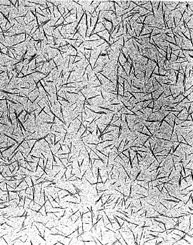Liquid crystalline suspensions of cellulose nanocrystals
Natural cellulose fibres are made
from long microfibrils of cellulose, of varying degrees of crystallinity,
depending on the source. By careful acid hydrolysis with sulphuric acid, it is
possible to dissolve the non-crystalline portions, leaving rod-like
nanocrystals of cellulose I.

TEM image of dilute
suspension on carbon grid. Typical nanocrystal dimensions, 200 nm long, 10 nm
wide
The nanocrystals are stabilized
in aqueous suspension by sulphate groups on the surface. At a critical
concentration, the suspensions form a chiral nematic ordered phase. ["Helicoidal Self-ordering of Cellulose Microfibrils in
Aqueous Suspension," J.-F. Revol, H.Bradford, J. Giasson, R.H.
Marchessault and D.G. Gray, Int. J. Biol. Macromol., 14, 170-172 (1992).]

The equilibrium between ordered
and disordered phases is sensitive to counterions, ionic strength, and added
polymers. ["Effect of Counterions on Ordered Phase
Formation in Suspensions of Charged Rodlike Cellulose Crystallites." Xue
Min Dong and Derek G. Gray, Langmuir, 13, 2404-2409 (1997).]